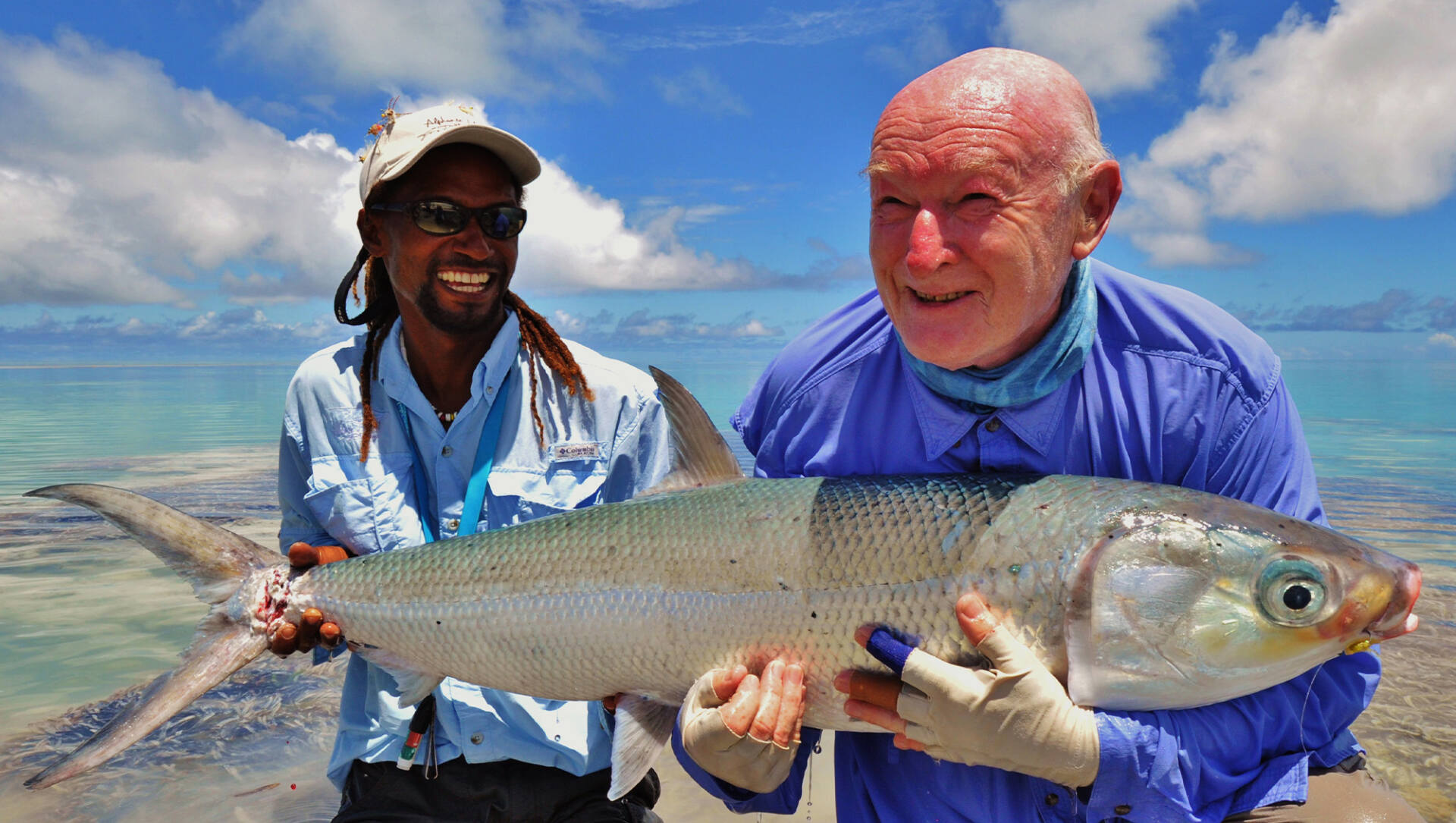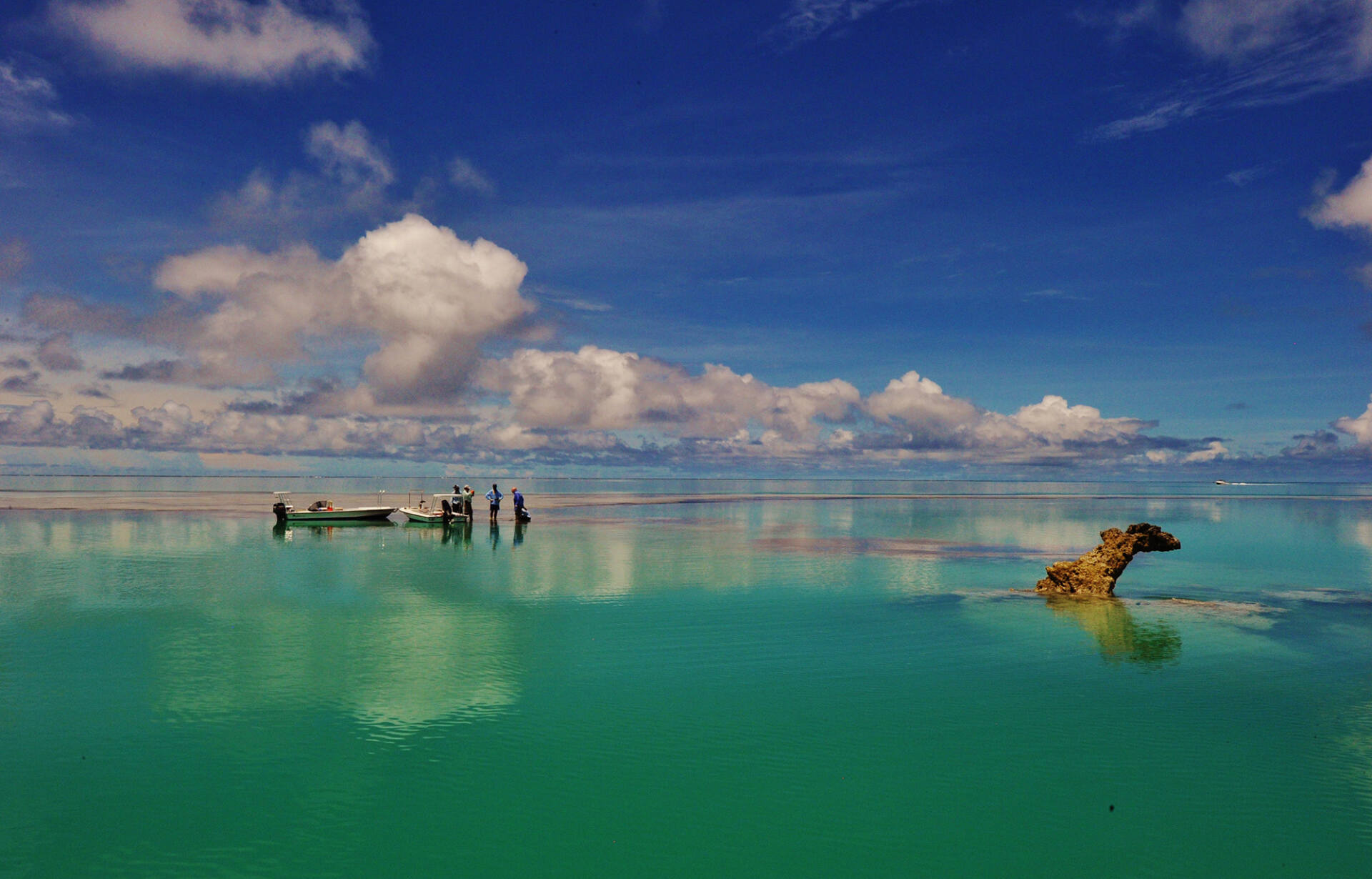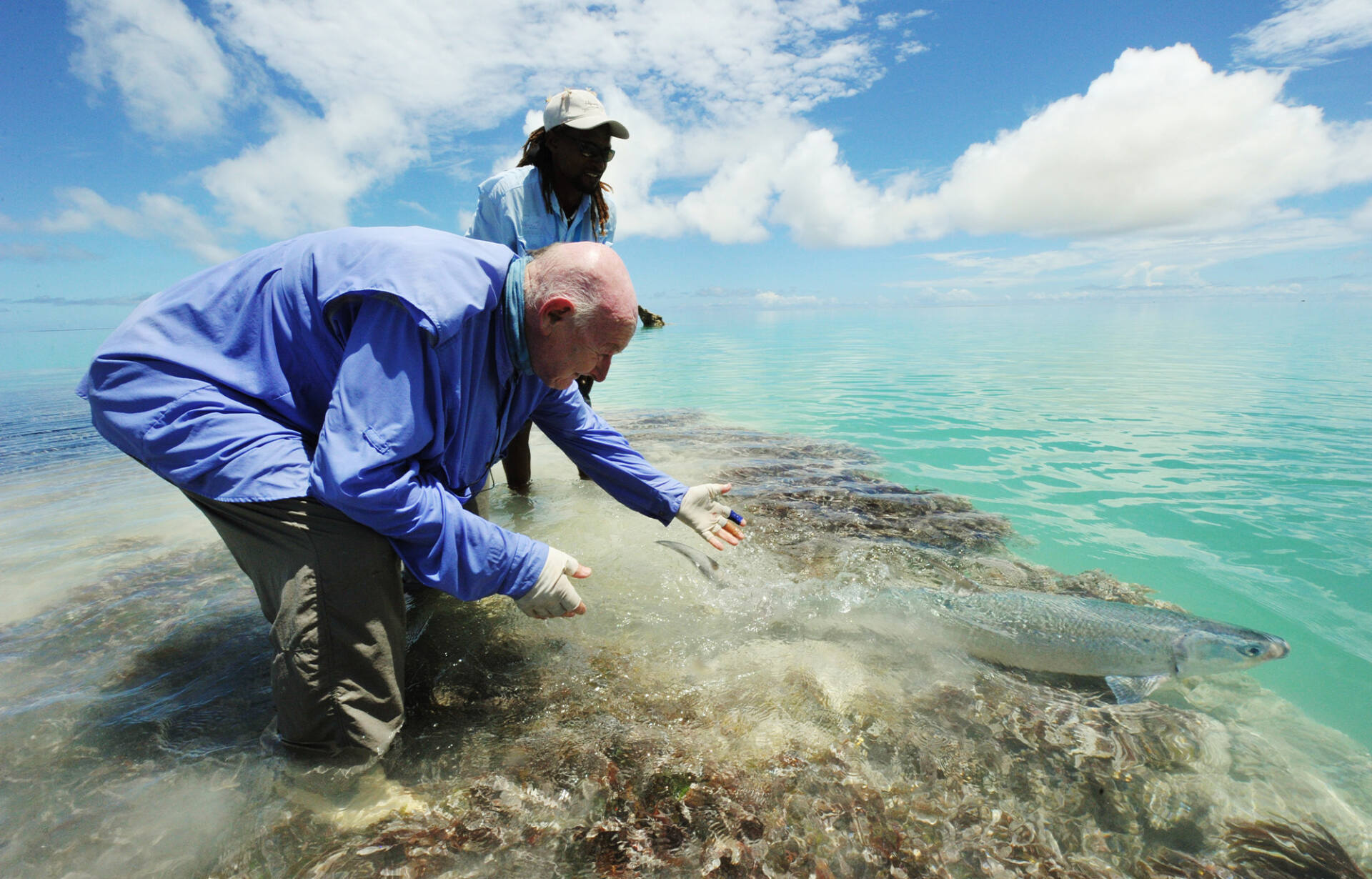 Tony Richards recounts a meeting with a huge milkfish in the Seychelles, the awesomely powerful, algae-grazing leviathans of the Indo-Pacific flats channels and reefs
Tony Richards recounts a meeting with a huge milkfish in the Seychelles, the awesomely powerful, algae-grazing leviathans of the Indo-Pacific flats channels and reefs
It was a typical Alphonse day. Warm, with a light breeze and wonderful sunshine.
I was accompanied by Michael Henderson and we were being guided by the superb Seychelloise guide, Serge. After being asked how we would like to spend our day fishing, we both said we were in his hands and would do whatever he suggested. Always a wise move to obey your guide. Milkfish were high on the agenda, so off we set to see if he could find any feeding ones.
After exploring many channels we ended up at a small channel near St. Joseph’s on the eastern side of the lagoon. The boat was beached and we started fishing, Michael with Serge on the deep-water side, and I was about 60 yards away, fishing the flats side, where a small stream of water flowed through a gap in the coral edge and over the flats.
The visibility was superb, aquamarine in the channel, crystal clear and white sand on the flats. In that channel was one feeding milkfish, which swam up the small channel for about 15 yards, then turned round, to swim back and up again repetitively, occasionally with its mouth open, half out of the water.
I was using my trusty 9ft 10-weight, which is a joy to cast.
The leader was straight 25lb Seaguar and the milkfish fly was one that I had bought at the well-equipped lodge on Alphonse. Lime green and wispy, it is tied to imitate the algae on which the milkfish graze, and it was probably a copy of the original invented and tied by Wayne XX.
Watching the fish perform its routine was wonderful, exciting and full of suspense. Its regularity enabled you to time your cast so that the fish would be in the area where your fly was being swept by the current, and hopefully both would meet.
After a few circuits the fish took the fly and we were connected for a milli-second before the fly lost hold and sprang back to me. Thinking I would have spooked it, I was surprised to find the fish seemed to be not the least bit disturbed by this momentary hook-up, and continued its rhythmical feeding pattern.
Minutes later, it was back in the channel and it took the fly again. Once more I connected with the fish, and after a 20-yard run the line slackened and the fly came back to me once more. Patience.
The fish returned to its routine as though nothing had happened although it could probably detect the increase in my pulse rate. More patient waiting, before it appeared again. To my amazement, the fish took the fly again and this time we were connected properly.
It seered straight down stream, for about 200 yards across the flat and then over the far side of the coral edge into the deeper water. It all happened so fast that I could do nothing to orevent the inevitable: my backing was severed on the sharp coral edge so I lost not only the fish, but also my fly line. Crestfallen, I made the short walk back to the beached boat.
I did not have a spare 10-weight line in my bag, so I decided to set up my 12-weight instead which I’d brougt along for targetting giant trevallys (GTs). At my age, and with my physique, I regard using a 12-weight rod as a form of punishment.
However, coupled with the lightweight milkfish fly, and not the usual ‘half a chicken’ that appears to be the norm for casting at GTs, it proved possible to put out quite a long line easily. Serge had joined me by now and commiserated with my disasters.
Now some milkfish were feeding in the deeper water above the small channel leading to the flat where I had been fishing.
 Again, from the shore, I was instructed to cast in their direction and to my delight they continued to feed. After a few blind casts another fish took, but just like the beginning of the session, it did not stay on for long. To my amazement this happened three more times and I suspect that at this stage Serge was becoming a little despondent at my inability to connect with them.
Again, from the shore, I was instructed to cast in their direction and to my delight they continued to feed. After a few blind casts another fish took, but just like the beginning of the session, it did not stay on for long. To my amazement this happened three more times and I suspect that at this stage Serge was becoming a little despondent at my inability to connect with them.
Patience was eventually rewarded and a fifth fish took. “Strip strike!” was the firm command. I did as told (who would dare disobey the guide?) and a solid take ensued.
The reel sang and in seconds something enormous jumped about 40 yards away. “What’s that?” I asked Serge, bemused.
“Your fish – Get in the boat!” came the reply. We were in hot pursuit. After a while, when the fish was on a shorter line, it became visible and to me looked rather like a grey submarine which we were to follow for a long time.
I have to emphasise that during the whole battle my part was just acting as a link between the magnificent expertise of Serge manoeuvring the boat and the phenomenal fish. Wherever the fish went the boat followed, and for a while, whilst the engine was in neutral, the fish was towing the boat.
I looked back to see what was happening to my partner, Michael. He was visible in the distance, alone and surrounded by water, and the thought entered my head that he could be preparing himself for a guest appearance on Desert Island Discs.
Coral heads were skilfully negotiated, but after a while the fish decided to explore the flats. Serge thought that the tide would be too low for the boat to follow the fish, but fortunately this proved to be wrong. Three times the flats were crossed, but with the fish on a relatively short line it was possible to prevent the leader being severed on any coral outcrops.
Eventually, we were both back in deep water and it felt a little safer. I later learned that Serge had the boat with the shallowest draught of all the skiffs. How very fortunate for me and how clever of him; if it had been a different boat then following the fish across the flats in the boat would not have been an option.
However, despite all this travelling, the fish had seemingly not tired. So I asked Serge what I was doing wrong. “Not putting it in the net”, was the laconic reply. I did not know what else I could do: the whole time maximum pressure was being applied to the fish with the rod low and the drag on the reel cranked down, virtually on full.
The fish might not have been tiring, but I certainly was. Changing the rod from my natural left to my right hand only provided temporary relief, and in my mind was always that horrible thought that the rod might be pulled out of my hand at the moment of change over. Furthermore, with the rod in the opposite hand no reel control is possible.
The fight continued in an interminable and exhausting fashion. In the later stages, Serge was more concerned about my exhaustion than the state of the fish.
Eventually, the milkfish’s sightseeing tour of the lagoon appeared to be coming to its end, and Serge asked me to raise the rod tip to lift it up in the water. This fish had never swum really deep – as milkfish often do – and in doing so they have managed previously to cut me off on coral.
However, it wasn’t all over yet, as my ability to lift the fish was partly limited by the inadequate strength of my exhausted arm-muscles, and my anxiety about the durability of my leader after such a testing time.
Fortunately, all held, and the fish surfaced, and we gasped at our first real view of its huge size. Serge was ready with the net.
However, we realised that suddenly we were not the only ones interested in our quarry.
From nowhere appeared a large shark that thought we were the providers of its lunch. No shark could be a match for Serge and the net was brought to bear heavily on its nose. Seconds later, the milkfish was safely in the folds of the net, and the boat was beached on the coral edge near the iconic Ignobilis that we all see so frequently when out in the skiffs.

The successful milkfish fly
Only when ashore did I realise the true size of the fish. It was vastly bigger than any I had been fortunate to land previously. The change over to a 12-weight rod had been a fortunate accident.
During the long drama Serge had been on the radio and now other boats appeared from all over the flats. Fortunately, one of them had kindly rescued the marooned Michael from his solitary position on the distant coral edge. Had he hooked a milkfish when on his own it would no doubt have spooled him.
The fish was photographed and measured, but I do not remember the exact details. It was ‘guesstimated’ at weighing about 55 pounds. There was some suggestion that it was a record, but as it was not weighed we will never know. Seeing it released and swimming away produced a wonderful feeling of relief.
‘Early release’ of fish that you are going to return is never a worry, but if it had been that particular fish, before we had seen its true magnitude, it would have been a real heartache.
Without Serge’s skills that fish would never have been netted. In all, the fight lasted about an hour and 20 minutes and the boat had moved, and often towed, about a mile-and-a-quarter. If ever there is to be an ambassador for being a vegetarian it has to be a milkfish.

Away she goes…
My luck continued to be with me that day as Brendan, guiding another boat, had found and rescued my lost 10-weight fly line, without an attached milkfish, alas. Had we been in contact with the mainland I would have immediately bought a lottery ticket.
My day was complete as on returning to the place where I’d hooked the fish, we found more milks were still feeding. Michael was soon into a fish, but sadly his rod broke during the fight. Nevertheless, the expert Serge still managed to net it for him.
What is a milkfish?
The silvery milkfish (Chanos chanos) occurs in the Indian and Pacific Oceans and is often encountered by saltwater fly fishers, as they are commonly found in tropical offshore marine waters around islands, reefs, estuaries and rivers, where giant trevally and permit might also be found.
They possess a sizeable forked tail fin, but have a toothless, small mouth with which they graze on cyanobacteria, algae and small invertebrates, rather like UK mullet.
Most milkfish attain no more than one metre in length, but some examples have been recorded at almost six feet long.



